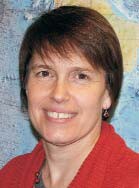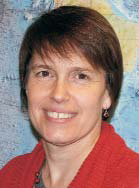O’Riordan takes VP reins at AIP
DOI: 10.1063/1.2982115
This month ocean scientist Catherine O’Riordan becomes the new vice president of the Physics Resources Center at the American Institute of Physics. In that post, she will direct AIP’s statistical research, history, education, media and government relations, magazines, and industrial outreach programs that serve 10 member societies, the public, and the corporate sector. The magazines division produces Physics Today. O’Riordan replaces former physics professor James Stith, who announced his retirement earlier this year following 10 years at AIP.
O’Riordan, who holds a doctorate in civil engineering from Stanford University and specializes in environmental fluid mechanics, was director of science development and education at the Consortium for Ocean Leadership, a nonprofit organization that represents 95 private and public ocean research institutions. Prior to that, she managed society and public affairs programs at the American Geophysical Union for eight years. O’Riordan says that her experiences at AGU familiarized her with AIP’s internal management structure and Governing Board. “I wanted to get back to working with associations,” she says. “Associations are unique environments, like a grassroots community that scientists build, and then the staff works on programs that provide services back to those scientists.”
Among the biggest challenges O’Riordan says she will face is to deliver products and programs to the physics community and the public at a time when journal subscriptions, AIP’s primary revenue, are stressed by changing market conditions. “We need to diversify our portfolio,” she says, noting that the Physics Resources Center could address budget concerns by further engaging in joint programs with the member societies and by obtaining public and private grants in a way that does not interfere with fundraising by the societies. O’Riordan also plans to work with the member societies on initiatives to improve diversity in the physics community and to expand AIP’s services to scientists outside the US. She would also like to strengthen the ties between the statistical research division and the industrial outreach program by providing workforce and career statistics that AIP’s corporate affiliates find valuable. “My impression is that we have great resources and that maybe we can do some more things to help the [industrial] community,” she says.
Prioritizing physics programs that often compete for the same resources will require the same thoughtful and measured style of leadership that Stith, a retired army colonel, demonstrated, says O’Riordan. Stith, who says he’s “retreading, not retiring,” plans to take a few months off before considering other long-term roles. He intends, however, to continue in current roles as adviser and board member for several science organizations and as an advocate for diversity in the physics community. A key to AIP’s future success, Stith suggests, will be to continue to build broad coalitions with other scientific organizations; during his tenure, for example, AIP built and led a partnership of 23 other organizations that manage the Discoveries and Breakthroughs Inside Science program, which annually produces 144 public information science video features for television.

O’Riordan
JON CORSIGLIA





